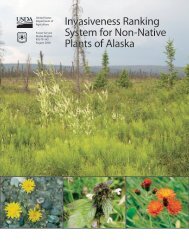AQIS Weed Risk Assessment - Alaska Natural Heritage Program
AQIS Weed Risk Assessment - Alaska Natural Heritage Program
AQIS Weed Risk Assessment - Alaska Natural Heritage Program
You also want an ePaper? Increase the reach of your titles
YUMPU automatically turns print PDFs into web optimized ePapers that Google loves.
Describe distribution:This species distributed all over the world except in extremely cold and arctic regions.Purple loosestrife is native to Eurasia, extending from Great Britain across westernEurope into central and southern Europe along the Mediterranean Basin. Japan is thecore of the species native range in Asia; populations extend to Southeast Asia andIndia (Blossey 2002). It is present in North Africa and North America. It is also foundin southeast temperate Australia (Bender and Rendall 1987).Rational:Sources of information:Bender, J. and J. Rendall. 1987. Element Stewardship Abstract for Lythrum salicariaPurple Loosestrife. The Nature Conservancy. Arlington, VA.Blossey, B. 2002. Purple Loosestrife. In: Driesche, R.V. et. al. 2002. BiologicalControl of Invasive Plants in the Eastern United States. USDA Forest ServicePublication FHTET-2002-04, 413 pp.3.5. Extent of the species U.S. range and/or occurrence of formal state orprovincial listingA. 0-5% of the states 0B. 6-20% of the states 2C. 21-50%, and/or state listed as a problem weed (e.g., “Noxious,” or “Invasive”) in 1 4state or Canadian provinceD. Greater than 50%, and/or identified as “Noxious” in 2 or more states or CanadianprovincesU. UnknownScore 5Documentation:Identify states invaded:Purple loosestrife occurs in nearly all states of the United States (USDA 2002). It is anoxious weed in 25 states and 2 Canadian provinces (Invaders Database System 2003).Rational:Sources of information:Invaders Database System. The University of Montana. 2003. Montana Noxious <strong>Weed</strong>Trust Fund. Department of Agriculture. http://invader.dbs.umt.edu/USDA (United States Department of Agriculture), NRCS (<strong>Natural</strong> ResourceConservation Service). 2002. The PLANTS Database, Version 3.5(http://plants.usda.gov). National Plant Data Center, Baton Rouge, LA 70874-4490 USA.Total Possible 25Total 224. FEASIBILITY OF CONTROL4.1. Seed banksA. Seeds remain viable in the soil for less than 3 years 0B. Seeds remain viable in the soil for between 3 and 5 years 2C. Seeds remain viable in the soil for 5 years and more 3U. UnknownScore 2Documentation:Identify longevity of seed bank:Viability of seeds decreased from 99% to 80% after two years of storage in a naturalbody of water (Bender and Rendall 1987). Seeds under cold dry storage remain highlyviable for at least 3 years, but longevity under field conditions is unknown (DiTomasoand Healy 2003).Rational:5Sources of information:9
















